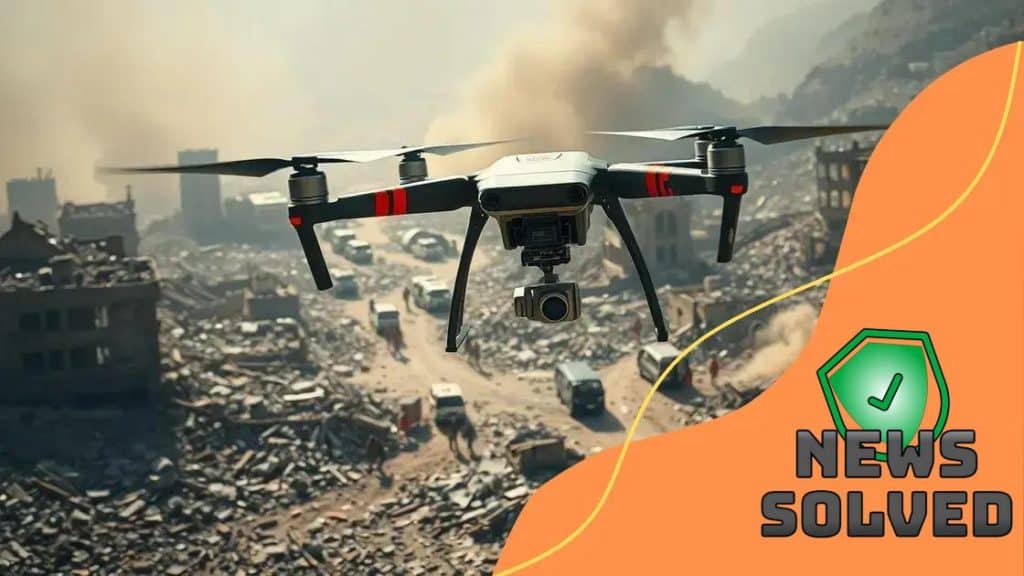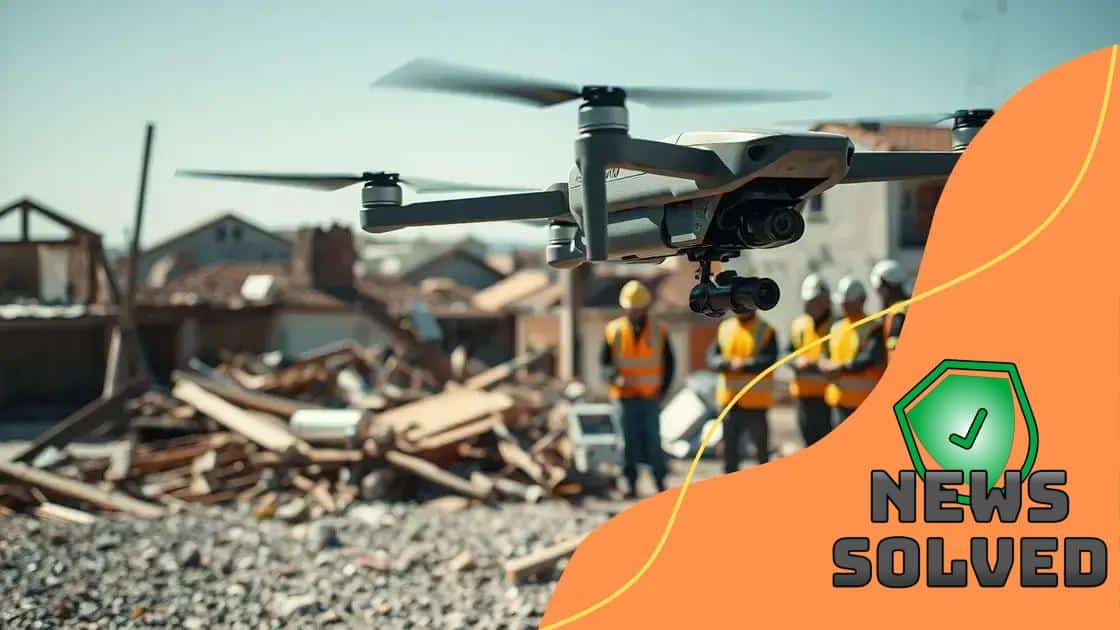The role of drones in disaster relief operations

Advertisements
The role of drones in disaster relief operations includes improving communication, assessing damage, locating victims, and delivering supplies efficiently, ultimately enhancing response efforts and saving lives.
The role of drones in disaster relief operations is transforming how we respond to emergencies. Imagine the speed of delivery and aerial surveillance that these devices provide. Curious about their impact?
Advertisements
Understanding the technology behind drones
Understanding the technology behind drones is essential for grasping their role in disaster relief. Drones are equipped with advanced features that allow them to navigate challenging environments, making them valuable tools in emergencies.
One critical aspect of drone technology is sensors. These devices utilize various types of sensors, such as GPS, infrared cameras, and LIDAR, to collect data and analyze the disaster area effectively.
Types of drones used in disaster response
There are several types of drones deployed during disaster relief efforts. Here are a few commonly used:
Advertisements
- Multirotor drones: Ideal for short flights and detailed surveys.
- Fixed-wing drones: Best for covering large areas quickly.
- Hybrid drones: Combine the advantages of both multirotor and fixed-wing designs.
The drone’s flight autonomy is another vital component. Many drones can fly for extended periods, covering vast distances without needing frequent recharging. This feature is crucial during disasters, when time is of the essence.
Communication and data transmission
Drones relay real-time data to ground teams, improving decision-making and response efficiency. High-speed communication links enable operators to receive crucial information instantly, ensuring that help reaches affected people as quickly as possible.
Moreover, the use of AI technology in drones enhances their capabilities. AI allows drones to process data on-site, making quick assessments of the situation without relying on human intervention. This advancement can significantly optimize rescue operations.
In conclusion, understanding the technology behind drones, including their sensors, types, flight autonomy, and communication capabilities, helps us appreciate their critical role in disaster relief operations. Their innovative features enable effective responses, saving time and potentially lives.
How drones enhance communication during disasters
Drones play a vital role in enhancing communication during disasters by providing real-time data and maintaining connectivity when traditional methods fail. Their ability to transmit information quickly helps first responders make informed decisions.
One way drones improve communication is through video streaming. Drones equipped with cameras can send live footage back to command centers. This capability allows teams to assess situations without putting themselves in danger.
Types of communication technologies used
Drones use various technologies to enhance communication in disaster zones. Here are a few key elements:
- Radio frequency communication: This allows drones to transmit data over long ranges.
- Satellite communication: Provides connectivity even in remote areas.
- Mesh networking: Creates a network of drones that can share information with each other and ground teams.
The integration of these technologies ensures that rescue teams can access crucial information promptly. For instance, when cell towers are down, drones equipped with satellite communication can bridge the gap.
Facilitating coordination among teams
Additionally, drones help different response teams communicate better. By sharing data such as maps and real-time images, teams can coordinate their efforts effectively. This coordination can significantly reduce response time and increase operational efficiency.
As communication methods evolve, drone technology continues to lead innovations in disaster response. Through effective communication, drones ensure that help reaches those in need quickly, ultimately saving lives.
Case studies of drones in action

Examining case studies of drones in action during disasters reveals their remarkable impact on response efforts. Each situation highlights their effectiveness and versatility in various scenarios.
One prominent example is the use of drones during the 2017 Hurricane Harvey disaster. Drones were used to assess flood damage and locate stranded individuals. Their aerial views provided emergency responders crucial information on inaccessible areas.
Success stories from real-life applications
Another notable case occurred during the California wildfires. Drones equipped with thermal imaging played a vital role in identifying hot spots and directing firefighting efforts. This technology helped firefighters monitor the situation closely without putting their safety at risk.
- Search and rescue operations: In the aftermath of earthquakes, drones have been instrumental in locating survivors trapped under debris.
- Delivery of supplies: In remote areas affected by disasters, drones have delivered medical supplies and food, ensuring urgent needs are met.
- Damage assessment: After natural disasters, drones quickly provide aerial assessments, helping teams allocate resources where they’re needed most.
During the COVID-19 pandemic, drones also found utility in monitoring quarantined areas and delivering vaccines. Their capability to fly over difficult terrains ensured that essential supplies reached people who needed them desperately.
By analyzing these case studies, it’s clear that drones are essential tools in disaster relief operations. They enhance response efforts and can adapt to various situations, proving invaluable in saving lives.
Challenges faced by drones in relief efforts
While drones play a crucial role in disaster relief, they also encounter several challenges that can hinder their effectiveness. Understanding these challenges is essential for improving their deployment in emergencies.
One major issue is regulatory restrictions. Many countries have strict regulations on drone flights, especially in disaster zones. This can limit response teams’ use of drones when they are most needed.
Environmental challenges
Drones also face obstacles posed by the environment. Factors like extreme weather conditions can significantly impact their performance. High winds and heavy rain can make flying difficult and reduce the quality of data collected.
- GPS interference: In some situations, GPS signals may be weak or unavailable, affecting navigation.
- Loss of communication: Drones can lose connection to their operators, particularly in mountainous or urban areas.
- Battery life limitations: Drones have limited flight time, which can restrict the area they can cover.
Additionally, the technical capabilities of drones can be a concern. Although technology is advancing, not all drones are equipped with the necessary tools for every disaster scenario. For example, the lack of thermal imaging in some drones can hinder search and rescue operations at night.
Public perception and acceptance
Finally, public perception can pose challenges. Some community members may be wary of drones due to concerns over privacy or safety. Gaining public trust is essential for the successful integration of drones in disaster response efforts.
By acknowledging these challenges, we can better prepare to leverage drone technology effectively in relief efforts, ensuring that their potential is fully realized during crises.
Future of drone technology in disaster management
The future of drone technology in disaster management looks promising, with advancements set to revolutionize how we respond to emergencies. As technology evolves, we can expect drones to become even more integral to disaster response efforts.
One significant area of development is autonomous flight. Future drones may navigate without human intervention, using AI to make decisions in real-time. This capability would allow drones to cover larger areas more efficiently.
Integration with other technologies
Future drones will likely integrate more closely with other technologies, such as IoT devices and big data analytics. This integration will provide responders with real-time insights, improving the coordination and effectiveness of mission efforts.
- Enhanced imaging technologies: Drones will be equipped with better cameras and sensors, allowing for more detailed assessments of disaster areas.
- Improved battery life: New battery technologies might enable longer flight times, enhancing a drone’s operational range.
- Advanced communication systems: Drones could use new communication methods that ensure reliable data transmission, even in remote areas.
Another exciting development is the potential use of swarm technology. This involves deploying multiple drones working together simultaneously. Swarms can cover large areas quickly and efficiently, making them ideal for search and rescue operations.
Training and regulations
As drone technology progresses, training for operators will also evolve. Future training programs will likely focus on utilizing advanced features and understanding how to leverage drones in disaster scenarios effectively.
Finally, regulations will need to adapt to keep pace with advancements in drone technology. Policymakers must develop guidelines that allow for innovation while ensuring public safety and privacy. By addressing these challenges, the future of drone technology in disaster management can enhance response efforts more significantly.
FAQ – Frequently Asked Questions about Drones in Disaster Relief
How do drones improve communication during disasters?
Drones enhance communication by providing real-time data and live video feeds to command centers, helping teams make informed decisions quickly.
What are the main challenges faced by drones in relief operations?
Drones face challenges such as regulatory restrictions, environmental factors like weather conditions, and technical limitations like battery life.
What future advancements can we expect in drone technology?
Future advancements may include autonomous flight capabilities, improved battery life, and better integration with other technologies for enhanced data collection.
How do drones contribute to disaster management efficiency?
Drones help in quickly assessing damage, locating victims, and delivering supplies, which significantly speeds up rescue and relief efforts.





